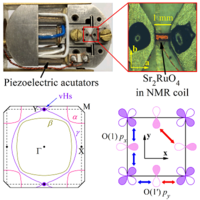Abstract
The effects of uniaxial compressive stress on the normal state nuclear-magnetic-resonance properties of the unconventional superconductor are reported. The paramagnetic shifts of both planar and apical oxygen sites show pronounced anomalies near the nominal -axis strain that maximizes the superconducting transition temperature . The spin susceptibility weakly increases on lowering the temperature below , consistent with an enhanced density of states associated with passing the Fermi energy through a van Hove singularity. Although such a Lifshitz transition occurs in the band formed by the Ru states hybridized with in-plane O orbitals, the large Hund’s coupling renormalizes the uniform spin susceptibility, which, in turn, affects the hyperfine fields of all nuclei. We estimate this “Stoner” renormalization by combining the data with first-principles calculations and conclude that this is an important part of the strain effect, with implications for superconductivity.
1 More- Received 23 September 2018
- Revised 1 February 2019
DOI:https://doi.org/10.1103/PhysRevX.9.021044
Published by the American Physical Society under the terms of the Creative Commons Attribution 4.0 International license. Further distribution of this work must maintain attribution to the author(s) and the published article’s title, journal citation, and DOI.
Published by the American Physical Society
Physics Subject Headings (PhySH)
Popular Summary
After 25 years of study, the unconventional superconductor continues to challenge researchers. While evidence for “in-triplet” pairing—where electrons pair up with their spins pointing in the same direction—emerges in several key measurements, other experimental outcomes are not easily understood in that framework. Resolving this issue is important to condensed-matter physicists because is a notable example of a strongly correlated, quasi-2D system that has few defects or impurities and because the underlying experimental techniques are used throughout the field of superconductivity.
A consequence of the proposed spin-triplet pairing is the expectation that when the material is strained, two different superconducting transition temperatures appear. Here, we use nuclear magnetic resonance to infer the strain-dependent spin susceptibility (a measure of the number of possible states at each energy level, known as the “density of states”), and we identify two physical consequences: an increase in the density of states at the Fermi energy and an associated enhancement in the Stoner factor, which is a signature of intensified ferromagnetic fluctuations that couple paired electrons.
Our study provides two possible explanations for the increase in the superconducting temperature in stressed : While the density-of-states effect is directly more beneficial in the case of spin-singlet pairing, the coincident enhanced Stoner factor could play a role in stabilizing a triplet state. Extending these investigations to the superconducting state will provide a more conclusive answer.



